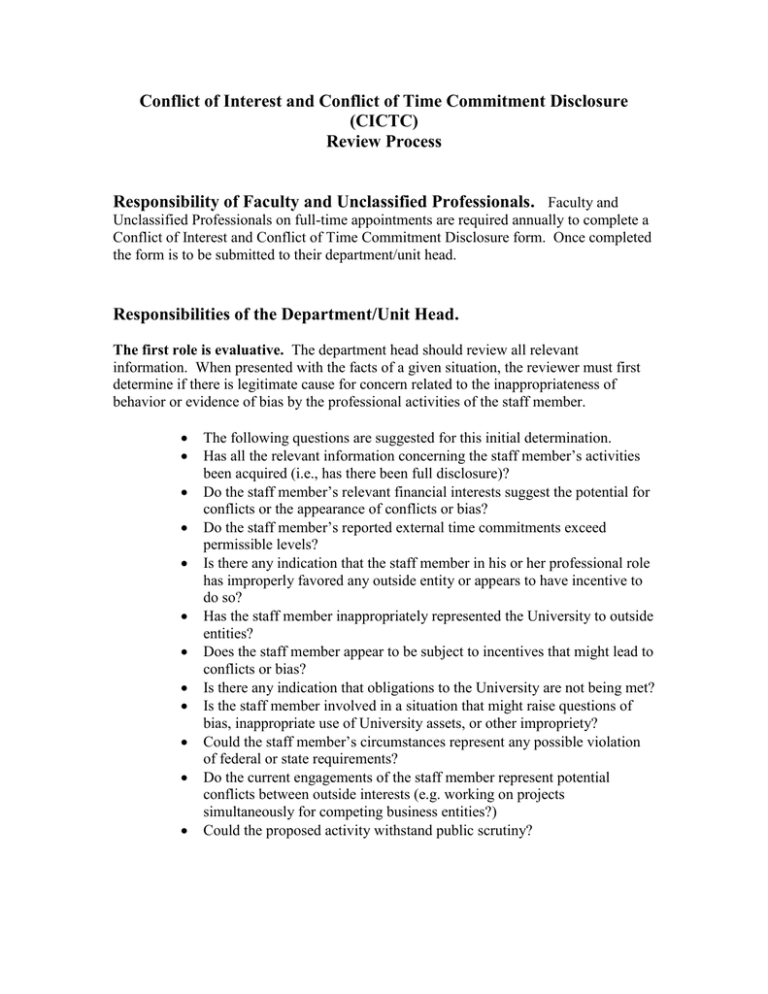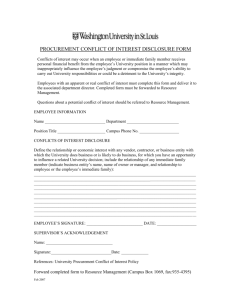Conflict of Interest and Conflict of Time Commitment Disclosure (CICTC) Review Process
advertisement

Conflict of Interest and Conflict of Time Commitment Disclosure (CICTC) Review Process Responsibility of Faculty and Unclassified Professionals. Faculty and Unclassified Professionals on full-time appointments are required annually to complete a Conflict of Interest and Conflict of Time Commitment Disclosure form. Once completed the form is to be submitted to their department/unit head. Responsibilities of the Department/Unit Head. The first role is evaluative. The department head should review all relevant information. When presented with the facts of a given situation, the reviewer must first determine if there is legitimate cause for concern related to the inappropriateness of behavior or evidence of bias by the professional activities of the staff member. The following questions are suggested for this initial determination. Has all the relevant information concerning the staff member’s activities been acquired (i.e., has there been full disclosure)? Do the staff member’s relevant financial interests suggest the potential for conflicts or the appearance of conflicts or bias? Do the staff member’s reported external time commitments exceed permissible levels? Is there any indication that the staff member in his or her professional role has improperly favored any outside entity or appears to have incentive to do so? Has the staff member inappropriately represented the University to outside entities? Does the staff member appear to be subject to incentives that might lead to conflicts or bias? Is there any indication that obligations to the University are not being met? Is the staff member involved in a situation that might raise questions of bias, inappropriate use of University assets, or other impropriety? Could the staff member’s circumstances represent any possible violation of federal or state requirements? Do the current engagements of the staff member represent potential conflicts between outside interests (e.g. working on projects simultaneously for competing business entities?) Could the proposed activity withstand public scrutiny? After appropriate evaluation, most situations will be found to be; a. b. c. Permissible since the disclosed information does not represent a possible source of bias or an inappropriate activity; Permissible with modifications aimed at avoiding bias or inappropriate activities; or Inconsistent with University policy and this not permissible. In a case where faculty activity is permitted but requires modifications. Department head’s should meet with the faculty member or unclassified professional to develop a management plan to be submitted to the next level with the CICTC form. Options are as numerous as the types of situations that may exist. Possible options include, but are not limited to: public disclosure of all relevant information; reformulation of the research work plan; close monitoring of the research project; divestiture of relevant personal interests; termination or reduction of involvement in the relevant research project; termination of inappropriate student involvement in projects; severance of outside relationships that pose conflicts; and reimbursement by the staff member to the University for indirect costs and for the use of laboratories, equipment, facilities and other resources. Department/Unit Head submits the CICTC Disclosure form to the dean for approval. Responsibilities of the Dean. Review the disclosure forms to assure that appropriate information exists to make the determination as to whether a conflict of interest exists. Meet as necessary with the department/unit head to discuss issues that may arise. The dean may elicit the review of the CICTC Disclosure Review Committee.




